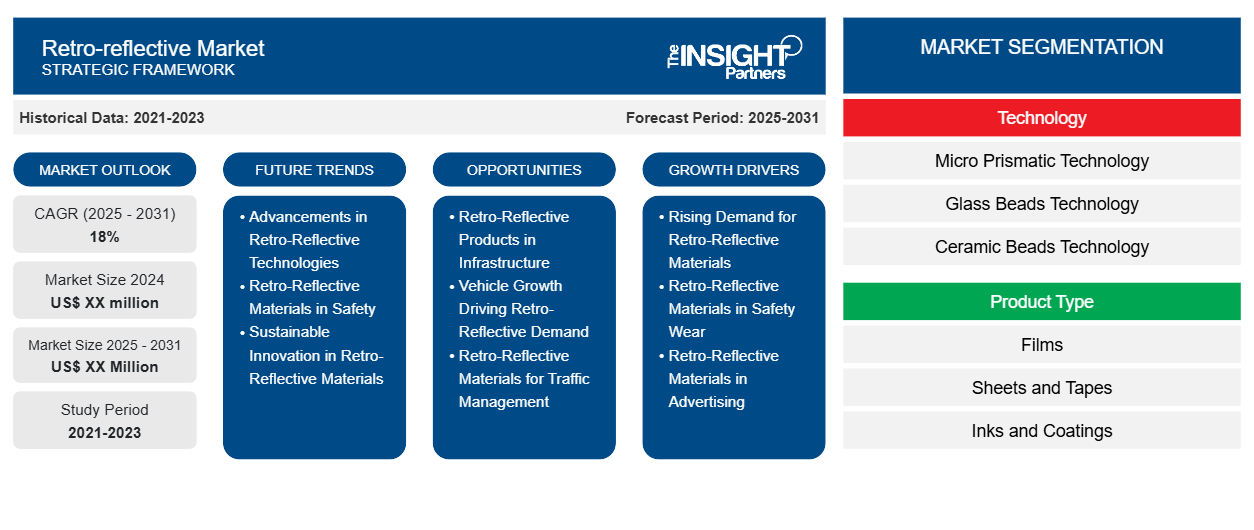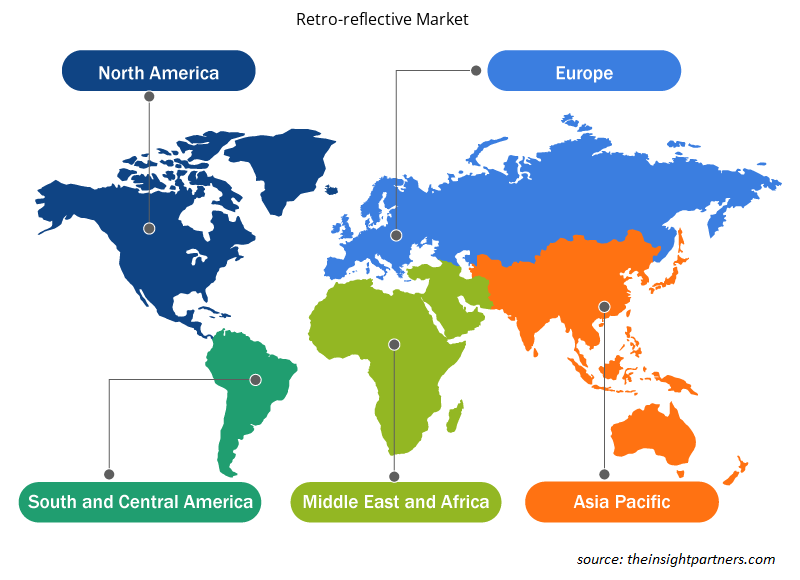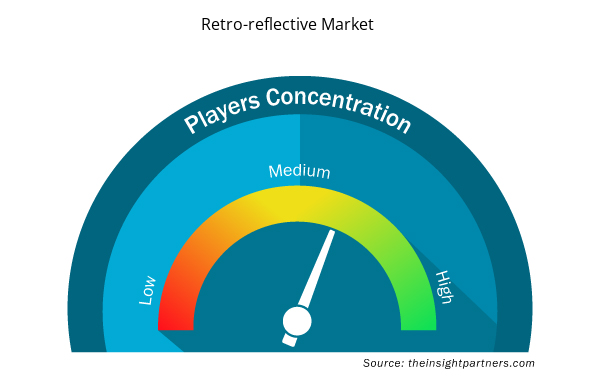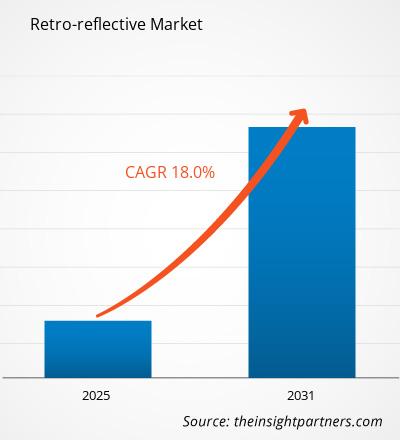Le marché rétroréfléchissant devrait enregistrer un TCAC de 18 % de 2024 à 2031, avec une taille de marché passant de XX millions USD en 2024 à XX millions USD d'ici 2031.
Le marché des matériaux rétroréfléchissants couvre l’analyse par technologie (technologie microprismatique, technologie des billes de verre et technologie des billes de céramique), type de produit (films, feuilles et rubans, encres et revêtements, et autres), et application (contrôle du trafic, vêtements de sécurité, automobile, industrie et autres), et géographie (Amérique du Nord, Europe, Asie-Pacifique, Moyen-Orient et Afrique, et Amérique du Sud et centrale). Le marché mondial des matériaux rétroréfléchissants devrait enregistrer un TCAC de 17,7 %. Le potentiel de croissance du secteur automobile dans les pays en développement et les activités croissantes de construction et de sécurité routière devraient stimuler le marché des matériaux rétroréfléchissants.
Objectif du rapport
Le rapport Retro-reflective Market de The Insight Partners vise à décrire le paysage actuel et la croissance future, les principaux facteurs moteurs, les défis et les opportunités. Cela fournira des informations à diverses parties prenantes commerciales, telles que :
- Fournisseurs/fabricants de technologie : pour comprendre l’évolution de la dynamique du marché et connaître les opportunités de croissance potentielles, leur permettant de prendre des décisions stratégiques éclairées.
- Investisseurs : Effectuer une analyse complète des tendances concernant le taux de croissance du marché, les projections financières du marché et les opportunités qui existent tout au long de la chaîne de valeur.
- Organismes de réglementation : Réglementer les politiques et surveiller les activités du marché dans le but de minimiser les abus, de préserver la confiance des investisseurs et de maintenir l’intégrité et la stabilité du marché.
Segmentation rétro-réfléchissante du marché
Technologie
- Technologie microprismatique
- Technologie des billes de verre
- Technologie des billes en céramique
Type de produit
- Films
- Feuilles et bandes
- Encres et revêtements
- Autres
Application
- Contrôle de la circulation
- Vêtements de sécurité
- Automobile
- Industriel
- Autres
Géographie
- Amérique du Nord
- Europe
- Asie-Pacifique
- Amérique du Sud et Amérique centrale
- Moyen-Orient et Afrique
Personnalisez ce rapport en fonction de vos besoins
Vous bénéficierez d'une personnalisation gratuite de n'importe quel rapport, y compris de certaines parties de ce rapport, d'une analyse au niveau des pays, d'un pack de données Excel, ainsi que de superbes offres et réductions pour les start-ups et les universités.
Marché rétro-réfléchissant : perspectives stratégiques

- Obtenez les principales tendances clés du marché de ce rapport.Cet échantillon GRATUIT comprendra une analyse de données, allant des tendances du marché aux estimations et prévisions.
Moteurs de croissance du marché rétro-réfléchissant
- Demande croissante de matériaux rétroréfléchissants : Les règles de sécurité routière de plus en plus strictes dans le monde font augmenter la demande de matériaux rétroréfléchissants. Les matériaux rétroréfléchissants offrent une meilleure visibilité la nuit et garantissent une diminution du nombre de victimes ou de pertes de vies humaines sur les routes. Une préoccupation croissante concernant les normes de sécurité des panneaux de signalisation, des véhicules et des vêtements de travail garantit également une croissance fluide du marché des matériaux rétroréfléchissants.
- Matériaux rétroréfléchissants dans les vêtements de sécurité : D'autres préoccupations telles que la sécurité sur les lieux de travail, en particulier dans les environnements à risques, ont conduit à l'utilisation de matériaux rétroréfléchissants dans la fabrication de vêtements de protection. La fabrication ou l'adoption de plus en plus fréquente d'équipements de sécurité à haute visibilité dans les industries, les mines ou la logistique accroît la demande de tissus, de bandes et de vêtements rétroréfléchissants.
- Matériaux rétroréfléchissants dans la publicité : Les matériaux rétroréfléchissants sont souvent utilisés dans le marketing et la publicité extérieure pour les publicités et les enseignes afin qu'elles soient suffisamment visibles en cas de faible luminosité. Alors que les zones de vente au détail ouvertes 24h/24 et 7j/7, les zones urbaines animées et même la publicité extérieure prolifèrent, le besoin d'enseignes publicitaires rétroréfléchissantes devient essentiel pour la visibilité nocturne et crée ainsi une demande accrue dans le secteur de la publicité.
Tendances futures du marché rétro-réfléchissantes
- Progrès dans les technologies rétroréfléchissantes : L'évolution des technologies rétroréfléchissantes est fortement influencée par une multitude de facteurs tels que l'amélioration des billes de verre, des réflecteurs à microprismes et des revêtements résistants à l'abrasion. Toutes ces avancées technologiques offrent de meilleures performances et des matériaux rétroréfléchissants beaucoup plus durables dans les secteurs du transport, de la sécurité et de la publicité.
- Matériaux rétroréfléchissants pour la sécurité : Les matériaux rétroréfléchissants sont utilisés pour marquer les zones où des mesures de sécurité sont nécessaires dans les secteurs de l'aviation et de la navigation. Parmi ces matériaux figurent les marquages de pistes, les panneaux de navigation et les équipements de sauvetage. L'expansion mondiale des réseaux de transport et l'augmentation des réglementations concernant l'amélioration des normes de sécurité ont été des facteurs clés qui ont accéléré l'utilisation de matériaux rétroréfléchissants.
- Innovation durable dans les matériaux rétroréfléchissants : La demande croissante pour une fabrication plus écologique a entraîné une forte impulsion vers le développement de matériaux rétroréfléchissants respectueux de l'environnement. L'innovation dans les revêtements rétroréfléchissants recyclables et à faible impact serait considérée comme un moteur de croissance accrue du marché, car les entreprises et les industries recherchent des solutions plus respectueuses de l'environnement tout en maintenant des niveaux très élevés de sécurité et de visibilité.
Opportunités de marché pour les produits rétroréfléchissants
- Produits rétroréfléchissants dans les infrastructures : En raison du développement rapide des infrastructures dans toutes les régions, y compris dans les pays en développement, les produits rétroréfléchissants deviennent rapidement populaires non seulement pour les panneaux de signalisation et les barrières routières, mais aussi pour les vêtements de sécurité. Les projets de construction et d'autoroutes à grande échelle suscitent des besoins de visibilité bien plus importants, avec des besoins accrus en produits rétroréfléchissants dans les villes et les zones rurales.
- La croissance des véhicules stimule la demande de produits rétroréfléchissants : L'augmentation de la production de véhicules et du trafic routier dans le monde entier nécessite une meilleure visibilité des marquages et des panneaux routiers. C'est là qu'une visibilité nocturne élevée pour les conducteurs et les piétons contribue à la croissance du marché, ce qui est positif pour les applications de transport et automobiles.
- Matériaux rétroréfléchissants pour la gestion du trafic : Il est donc devenu nécessaire d'utiliser des matériaux rétroréfléchissants pour assurer un système efficace de gestion du trafic dans les zones urbaines encombrées. Ces panneaux de signalisation, marquages au sol et barrières fabriqués à partir de matériaux rétroréfléchissants améliorent la fluidité du trafic, contribuent à réduire les accidents et facilitent la mise en réseau sécurisée des routes.
Perspectives régionales du marché rétro-réfléchissant
Les tendances et facteurs régionaux influençant le marché des rétroréfléchissants tout au long de la période de prévision ont été expliqués en détail par les analystes d’Insight Partners. Cette section traite également des segments et de la géographie du marché des rétroréfléchissants en Amérique du Nord, en Europe, en Asie-Pacifique, au Moyen-Orient et en Afrique, ainsi qu’en Amérique du Sud et en Amérique centrale.

- Obtenez les données régionales spécifiques au marché rétroréfléchissant
Portée du rapport sur le marché des dispositifs rétroréfléchissants
| Attribut de rapport | Détails |
|---|---|
| Taille du marché en 2024 | XX millions de dollars américains |
| Taille du marché d'ici 2031 | XX millions de dollars américains |
| Taux de croissance annuel composé mondial (2025-2031) | 18% |
| Données historiques | 2021-2023 |
| Période de prévision | 2025-2031 |
| Segments couverts | Par technologie
|
| Régions et pays couverts | Amérique du Nord
|
| Leaders du marché et profils d'entreprises clés |
|
Densité des acteurs du marché rétro-réfléchissante : comprendre son impact sur la dynamique des entreprises
Le marché des produits rétroréfléchissants connaît une croissance rapide, stimulée par la demande croissante des utilisateurs finaux en raison de facteurs tels que l'évolution des préférences des consommateurs, les avancées technologiques et une plus grande sensibilisation aux avantages du produit. À mesure que la demande augmente, les entreprises élargissent leurs offres, innovent pour répondre aux besoins des consommateurs et capitalisent sur les tendances émergentes, ce qui alimente davantage la croissance du marché.
La densité des acteurs du marché fait référence à la répartition des entreprises ou des sociétés opérant sur un marché ou un secteur particulier. Elle indique le nombre de concurrents (acteurs du marché) présents sur un marché donné par rapport à sa taille ou à sa valeur marchande totale.
Les principales entreprises opérant sur le marché rétroréfléchissant sont :
- Entreprise 3M
- Américaine et Efird LLC
- Peintures Asiatiques Limitée
- Société Avery Dennison
- Changzhou Hua R Sheng Matériau réfléchissant Co., Ltd.
Avis de non-responsabilité : les sociétés répertoriées ci-dessus ne sont pas classées dans un ordre particulier.

- Obtenez un aperçu des principaux acteurs du marché rétro-réfléchissant
Principaux arguments de vente
- Couverture complète : Le rapport couvre de manière exhaustive l’analyse des produits, des services, des types et des utilisateurs finaux du marché rétroréfléchissant, offrant un paysage holistique.
- Analyse d’experts : Le rapport est compilé sur la base d’une compréhension approfondie des experts et analystes du secteur.
- Informations à jour : Le rapport garantit la pertinence commerciale en raison de sa couverture des informations récentes et des tendances des données.
- Options de personnalisation : ce rapport peut être personnalisé pour répondre aux exigences spécifiques du client et s'adapter parfaitement aux stratégies commerciales.
Le rapport de recherche sur le marché des rétroréfléchissants peut donc aider à ouvrir la voie au décodage et à la compréhension du scénario de l’industrie et des perspectives de croissance. Bien qu’il puisse y avoir quelques préoccupations valables, les avantages globaux de ce rapport ont tendance à l’emporter sur les inconvénients.
- Analyse historique (2 ans), année de base, prévision (7 ans) avec TCAC
- Analyse PEST et SWO
- Taille du marché Valeur / Volume - Mondial, Régional, Pays
- Industrie et paysage concurrentiel
- Ensemble de données Excel



Report Coverage
Revenue forecast, Company Analysis, Industry landscape, Growth factors, and Trends

Segment Covered
This text is related
to segments covered.

Regional Scope
North America, Europe, Asia Pacific, Middle East & Africa, South & Central America

Country Scope
This text is related
to country scope.
Questions fréquemment posées
The North America market is expected to account for the highest CAGR during the forecast period owing to the growing construction industry in the region.
The films and sheets product type segment accounted for the largest market share in 2023
3M Company, ORAFOL, Asian Paints PPG, Reflomax, Avery Dennison, Nippon Carbide Industries, Taiwan Paiho Ltd, Changzhou Hua Sheng, DM reflective material co ltd, and Honeywell International Inc are some of the key players in the market.
Growing infrastructure projects is a key driver in the market
The Retro-reflective Market is estimated to witness a CAGR of 18% from 2023 to 2031
Technological developments is an emerging trend in the market.
Trends and growth analysis reports related to Chemicals and Materials : READ MORE..
The List of Companies
- 3M Company
- American & Efird LLC
- Asian Paints Limited
- Avery Dennison Corporation
- Changzhou Hua R Sheng Reflective Material Co., Ltd.
- Coats Group plc
- Nippon Carbide Industries Co., Inc.
- ORAFOL Europe GmbH
- Paiho Group
- REFLOMAX Co., Ltd.
The Insight Partners performs research in 4 major stages: Data Collection & Secondary Research, Primary Research, Data Analysis and Data Triangulation & Final Review.
- Data Collection and Secondary Research:
As a market research and consulting firm operating from a decade, we have published and advised several client across the globe. First step for any study will start with an assessment of currently available data and insights from existing reports. Further, historical and current market information is collected from Investor Presentations, Annual Reports, SEC Filings, etc., and other information related to company’s performance and market positioning are gathered from Paid Databases (Factiva, Hoovers, and Reuters) and various other publications available in public domain.
Several associations trade associates, technical forums, institutes, societies and organization are accessed to gain technical as well as market related insights through their publications such as research papers, blogs and press releases related to the studies are referred to get cues about the market. Further, white papers, journals, magazines, and other news articles published in last 3 years are scrutinized and analyzed to understand the current market trends.
- Primary Research:
The primarily interview analysis comprise of data obtained from industry participants interview and answers to survey questions gathered by in-house primary team.
For primary research, interviews are conducted with industry experts/CEOs/Marketing Managers/VPs/Subject Matter Experts from both demand and supply side to get a 360-degree view of the market. The primary team conducts several interviews based on the complexity of the markets to understand the various market trends and dynamics which makes research more credible and precise.
A typical research interview fulfils the following functions:
- Provides first-hand information on the market size, market trends, growth trends, competitive landscape, and outlook
- Validates and strengthens in-house secondary research findings
- Develops the analysis team’s expertise and market understanding
Primary research involves email interactions and telephone interviews for each market, category, segment, and sub-segment across geographies. The participants who typically take part in such a process include, but are not limited to:
- Industry participants: VPs, business development managers, market intelligence managers and national sales managers
- Outside experts: Valuation experts, research analysts and key opinion leaders specializing in the electronics and semiconductor industry.
Below is the breakup of our primary respondents by company, designation, and region:

Once we receive the confirmation from primary research sources or primary respondents, we finalize the base year market estimation and forecast the data as per the macroeconomic and microeconomic factors assessed during data collection.
- Data Analysis:
Once data is validated through both secondary as well as primary respondents, we finalize the market estimations by hypothesis formulation and factor analysis at regional and country level.
- Macro-Economic Factor Analysis:
We analyse macroeconomic indicators such the gross domestic product (GDP), increase in the demand for goods and services across industries, technological advancement, regional economic growth, governmental policies, the influence of COVID-19, PEST analysis, and other aspects. This analysis aids in setting benchmarks for various nations/regions and approximating market splits. Additionally, the general trend of the aforementioned components aid in determining the market's development possibilities.
- Country Level Data:
Various factors that are especially aligned to the country are taken into account to determine the market size for a certain area and country, including the presence of vendors, such as headquarters and offices, the country's GDP, demand patterns, and industry growth. To comprehend the market dynamics for the nation, a number of growth variables, inhibitors, application areas, and current market trends are researched. The aforementioned elements aid in determining the country's overall market's growth potential.
- Company Profile:
The “Table of Contents” is formulated by listing and analyzing more than 25 - 30 companies operating in the market ecosystem across geographies. However, we profile only 10 companies as a standard practice in our syndicate reports. These 10 companies comprise leading, emerging, and regional players. Nonetheless, our analysis is not restricted to the 10 listed companies, we also analyze other companies present in the market to develop a holistic view and understand the prevailing trends. The “Company Profiles” section in the report covers key facts, business description, products & services, financial information, SWOT analysis, and key developments. The financial information presented is extracted from the annual reports and official documents of the publicly listed companies. Upon collecting the information for the sections of respective companies, we verify them via various primary sources and then compile the data in respective company profiles. The company level information helps us in deriving the base number as well as in forecasting the market size.
- Developing Base Number:
Aggregation of sales statistics (2020-2022) and macro-economic factor, and other secondary and primary research insights are utilized to arrive at base number and related market shares for 2022. The data gaps are identified in this step and relevant market data is analyzed, collected from paid primary interviews or databases. On finalizing the base year market size, forecasts are developed on the basis of macro-economic, industry and market growth factors and company level analysis.
- Data Triangulation and Final Review:
The market findings and base year market size calculations are validated from supply as well as demand side. Demand side validations are based on macro-economic factor analysis and benchmarks for respective regions and countries. In case of supply side validations, revenues of major companies are estimated (in case not available) based on industry benchmark, approximate number of employees, product portfolio, and primary interviews revenues are gathered. Further revenue from target product/service segment is assessed to avoid overshooting of market statistics. In case of heavy deviations between supply and demand side values, all thes steps are repeated to achieve synchronization.
We follow an iterative model, wherein we share our research findings with Subject Matter Experts (SME’s) and Key Opinion Leaders (KOLs) until consensus view of the market is not formulated – this model negates any drastic deviation in the opinions of experts. Only validated and universally acceptable research findings are quoted in our reports.
We have important check points that we use to validate our research findings – which we call – data triangulation, where we validate the information, we generate from secondary sources with primary interviews and then we re-validate with our internal data bases and Subject matter experts. This comprehensive model enables us to deliver high quality, reliable data in shortest possible time.

 Obtenez un échantillon gratuit pour ce rapport
Obtenez un échantillon gratuit pour ce rapport